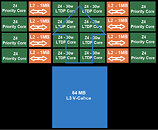
Chinese Firm Montage Repackages Intel's 5th Generation Emerald Rapids Xeon Processor into Domestic Product Lineup
Chinese chipmaker Montage Technology has unveiled new data center processors under its Jintide brand based on Intel's latest Emerald Rapids Xeon architecture. The 5th generation Jintide lineup offers anywhere from 16-core to 48-core options for enterprise customers needing advanced security specific to China's government and enterprise requirements. Leveraging a long-running joint venture with Intel, Jintide combines standard high-performance Xeon microarchitectures with added on-die monitoring and encryption blocks, PrC (Pre-check) and DSC (Dynamic Security Check), which are security-hardened for sensitive Chinese use cases. The processors retain all core performance attributes of Intel's vanilla offerings thanks to IP access, only with extra protections mandated by national security interests. While missing the very highest core counts, the new Jintide chips otherwise deliver similar Emerald Rapids features like 8-channel DDR5-5600 memory, 80 lanes of speedy PCIe 5.0, and elevated clock speeds over 4.0 GHz at peak. The Jintide processors have 2S scaling, which allows for dual-socket systems with up to 96 cores and 192 threads.
Pricing remains unpublished but likely carries a premium over Intel list prices thanks to the localized security customization required. However, with Jintide uniquely meeting strict Chinese government and data regulations, cost becomes secondary for target customers needing compliant data center hardware. After matching lockstep with Intel's last several leading Xeon generations, Jintide's continued iteration highlights its strategic value in enabling high-performance domestic infrastructure as China eyes IT supply chain autonomy. Intel gets expanded access to the growing Chinese server market, while Chinese partners utilize Intel IP to strengthen localized offerings without foreign dependency. It manifests the delicate balance of advanced chip joint ventures between global tech giants and rising challengers. More details about the SKUs are listed in the table below.
Pricing remains unpublished but likely carries a premium over Intel list prices thanks to the localized security customization required. However, with Jintide uniquely meeting strict Chinese government and data regulations, cost becomes secondary for target customers needing compliant data center hardware. After matching lockstep with Intel's last several leading Xeon generations, Jintide's continued iteration highlights its strategic value in enabling high-performance domestic infrastructure as China eyes IT supply chain autonomy. Intel gets expanded access to the growing Chinese server market, while Chinese partners utilize Intel IP to strengthen localized offerings without foreign dependency. It manifests the delicate balance of advanced chip joint ventures between global tech giants and rising challengers. More details about the SKUs are listed in the table below.





































































